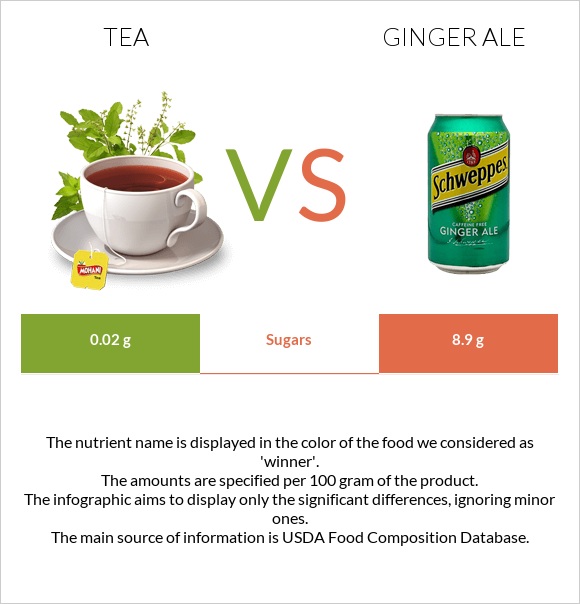Tea vs. Ginger ale — In-Depth Nutrition Comparison
Compare
Summary of differences between tea and ginger ale
- Ginger ale has less manganese than tea.
- Tea covers your daily need for manganese, 16% more than ginger ale.
- The glycemic index of ginger ale is higher.
These are the specific foods used in this comparison Beverages, tea, instant, unsweetened, prepared with water and Beverages, carbonated, ginger ale.
Infographic

Infographic link
Mineral Comparison
Mineral comparison score is based on the number of minerals by which one or the other food is richer. The "coverage" charts below show how much of the daily needs can be covered by 300 grams of the food.
| Contains more MagnesiumMagnesium | +100% |
| Contains more PotassiumPotassium | +1700% |
| Contains more PhosphorusPhosphorus | +∞% |
| Contains less SodiumSodium | -42.9% |
| Contains more ManganeseManganese | +2915.4% |
| Contains more IronIron | +1700% |
| Contains more CopperCopper | +63.6% |
| Contains more ZincZinc | +400% |
| Contains more SeleniumSelenium | +∞% |
Vitamin Comparison
Vitamin comparison score is based on the number of vitamins by which one or the other food is richer. The "coverage" charts below show how much of the daily needs can be covered by 300 grams of the food.
| Contains more Vitamin B2Vitamin B2 | +∞% |
| Contains more Vitamin B3Vitamin B3 | +∞% |
| Contains more Vitamin B5Vitamin B5 | +∞% |
| Contains more Vitamin B6Vitamin B6 | +∞% |
All nutrients comparison - raw data values
| Nutrient |  |
 |
DV% diff. |
| Manganese | 0.392mg | 0.013mg | 16% |
| Fructose | 3.7g | 5% | |
| Carbs | 0.17g | 8.76g | 3% |
| Caffeine | 11mg | 0mg | 3% |
| Calories | 1kcal | 34kcal | 2% |
| Iron | 0.01mg | 0.18mg | 2% |
| Potassium | 18mg | 1mg | 1% |
| Copper | 0.011mg | 0.018mg | 1% |
| Protein | 0.06g | 0g | 0% |
| Net carbs | 0.17g | 8.76g | N/A |
| Magnesium | 2mg | 1mg | 0% |
| Calcium | 3mg | 3mg | 0% |
| Sugar | 0.02g | 8.9g | N/A |
| Zinc | 0.01mg | 0.05mg | 0% |
| Phosphorus | 1mg | 0mg | 0% |
| Sodium | 4mg | 7mg | 0% |
| Selenium | 0µg | 0.1µg | 0% |
| Vitamin B2 | 0.003mg | 0mg | 0% |
| Vitamin B3 | 0.032mg | 0mg | 0% |
| Vitamin B5 | 0.013mg | 0mg | 0% |
| Vitamin B6 | 0.001mg | 0mg | 0% |
| Choline | 0.3mg | 0mg | 0% |
Macronutrient Comparison
Macronutrient breakdown side-by-side comparison
Protein:
0.06 g
Fats:
0 g
Carbs:
0.17 g
Water:
99.62 g
Other:
0.15 g
Protein:
0 g
Fats:
0 g
Carbs:
8.76 g
Water:
91.23 g
Other:
0.01 g
| Contains more ProteinProtein | +∞% |
| Contains more OtherOther | +1400% |
| Contains more CarbsCarbs | +5052.9% |
~equal in
Fats
~0g
~equal in
Water
~91.23g





